TERRORISM
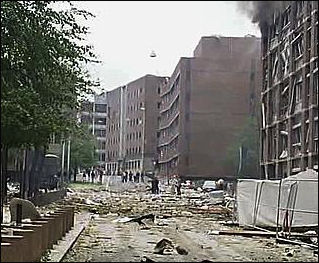
Norway Oslo explosion Terrorism is defined as violence towards civilian targets whereas insurgent activity is defined as violence against military targets. The aim of many terrorists is to go after “soft” targets in which a maximum number of people can be killed with little chance of the terrorist being caught. Soft targets include things like subways, markets, shopping areas, buses — places where a lot of people gather and security is minimal.
But this isn’t the only definition. One study found 109 different definitions of terrorism. According to the FBI terrorism is if you commit a crime that endangers another person or is violent with a broader intent to intimidate, influence or change policy or opinion.
One of the primary justifications for terrorism has traditionally been that it is the only way for a weak political unit to fight against a more powerful nation. Many of the tactics and goals of terrorism are similar to those of guerilla warfare and Maoism.
National Counterterrorism Center 2010 Report on Terrorism National Counterterrorism Center 2010 Report on Terrorism ; Search for International Terrorist Entities (SITE),
Terrorism Numbers
According to the National Counterterrorism Center 2010 Report on Terrorism: “Over 11,500 terrorist attacks occurred in 72 countries in 2010, resulting in approximately 50,000 victims, including almost 13,200 deaths. Although the number of attacks rose by almost 5 percent over the previous year, the number of deaths declined for a third consecutive year, dropping 12 percent from 2009. This decline reflected a combination of two factors: a decrease in the number of attacks causing more than five deaths along with an increase in attacks causing no deaths. For the second year in a row, the largest number of reported attacks occurred in South Asia which also had the largest number of victims for the third consecutive year. More than 75 percent of theworld’s terrorist attacks and deaths took place in South Asia and the Near East. The Near East and South Asia in 2010 suffered a combined total of 8,960 attacks that caused 9,960 deaths. [Source: National Counterterrorism Center website]
For Americans, their chance of dying in a terrorist attack are less than their chance of drowning in their own bathtub.
According to the U.S. State Department annual “Country Report on terrorism” in 2007 global terrorism fatalities reached 20,498 in 2006, a 40 percent jump from the 14,618 in 2005. The increase was due mainly to increased violence in Iraq, where about 13,400 deaths occurred. The number of terrorist incidents in 2006 13,338 in 2006, ip from 11,153 in 2005, with 6,630 in Iraq, up from 3,468 in 2005. The second highest number of terrorist attacks was in Afghanistan, where there were 749 attacks in 2006, up from 491 in 2005.
The National Counterterrorism Center provides statistical data for the U.S. State Department. It recorded more than 11,000 terrorist acts in 2005, resulting in more than 14,600 deaths and 25,000 injuries with most of the casualties in the Muslim world, mostly Iraq. In 2004, the organization counted 3,192 terrorist acts resting in 28,000 casualties (the increase was largely due to new ways of counting the incidents). In 2004, there were 650 significant terrorism attacks worldwide, up from 175 in 2003. Much of the increase was attribute to the rise in the number of attacks in Iraq.
National Counterterrorism Center 2010 Report on Terrorism National Counterterrorism Center 2010 Report on Terrorism
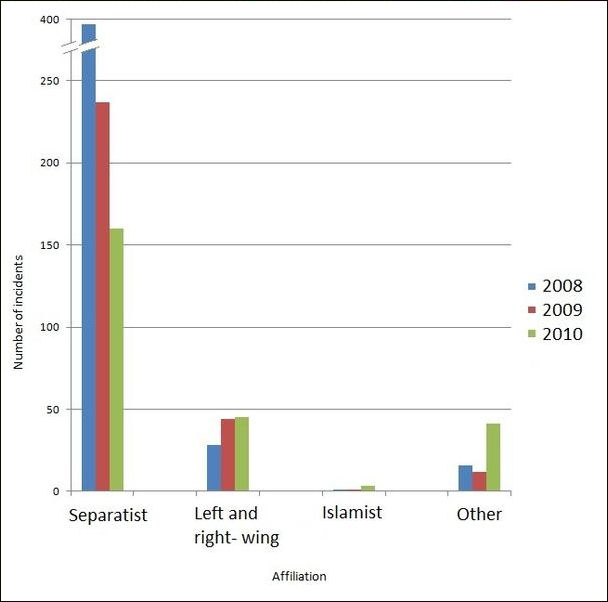
Motivations, Aims and Reasons for Terrorism
Many have felt that the primary motivation for terrorists in recent decades has been is the presence of the United States in Iraq and injustices inflicted by the Israelis on the Palestinians. Former CIA operative and Middle East expert Tobert Baer told the Times: What Muslims “see is that we attack Muslims, we provoke the killing of Muslims...we provoke what they call “ fitna”, which is chaos among the Muslims. They see it as neo-colonialism, hate for Muslims.”
Studies by psychologists suggest that terrorists are motivated by perceived humiliation, deprivation and fear. One Kashmiri militant told the Los Angeles Times. “Sometimes depravation is imagined, as in America. In Kashmir it real. But it doesn’t really matter whether it is real or imagined.
Modernity and rapid change and the dislocation and alienation they breed are blamed. As the rich get richer and more visible the poor get more angry sometimes those with ambition and education that are left out turn to terrorism as a way to make their lives (and deaths) meaning ful.
Doyle McManus wrote in the Los Angeles Times: “Terrorists aim to damage their opponents partly by provoking reactions bigger than the original attack. Osama bin Laden spent less than half a million dollars on the Sept. 11, 2001, attacks in New York and Washington, but he caused billions in damage by prompting a shutdown of financial markets, air travel and other chunks of the U.S. economy — not to mention the war in Afghanistan and the other counterterrorist campaigns that ensued. [Source: Doyle McManus, Los Angeles Times, December 26, 2010]

Roots and Sociological Forces Behind Terrorism
Anita Snow of Associated Press: Many analysts believed to be that the roots of terrorism lie in things such as poverty and intolerence not just ideas about jihad and anti-Americanism. The U.N. Security Council said terrorism "will not be defeated by military force, law enforcement measures, and intelligence operations alone.” and that a lack of development, peace and security, and human rights can help spread terrorism, and that rule of law, peaceful resolution of prolonged conflicts, good governance, tolerance and the protection of fundamental freedoms can "offer a viable alternative to those who could be susceptible to terrorist recruitment and to radicalization leading to violence." [Source: Anita Snow, The Associated Press, September 2010]
U.N. Secretary-General Ban Ki-moon said "Education, development, intercultural dialogue and conflict prevention all have growing relevance in addressing conditions conducive to the spread of terrorism..."We must do more to understand the reasons people are drawn to violence, so that we can do more to prevent others from following that path.” The council also called for more co-ordination among countries to combat terrorism.
“Many Muslims feel a powerful sense of moral outrage at the treatment of their coreligionists,” Marc Sageman wrote, “be it the sight of U.S. troops killing Muslims in Iraq or the aftermath of police harassment of local mosques. To lead to political violence, a next-generation jihadist must come to believe one simple sound bite: that there is a "war against Islam." Louise Richardson wrote in the New York Times, One does not have to be an apologist for terrorism to recognize that many of these grievances — occupation, political disenfranchisement, confinement in refugee camps — may be quite concrete and far from slight. One has only to read the statements or listen to the audiotapes of terrorist leaders to detect more cold calculation than what Burleigh terms obsessional killing rage. [Source: Louise Richardson, New York Times, April 24, 2009]
Marc Sageman wrote in Washington Post: “What makes next-gen terrorists tick? How did these ordinary kids come to be so attracted to political violence? The process of radicalization consists of four prongs, which need not occur in sequence. Here's the recipe: having a sense of moral outrage; seeing this anger as part of a "war on Islam"; believing that this view is consistent with one's everyday grievances; and mobilizing through networks. [Source:Marc Sageman, Washington Post , June 8, 2008; Sageman is a sociologist, forensic psychiatrist and scholar in residence at the New York Police Department. He is the author of "Understanding Terror Networks" and "Leaderless Jihad."]
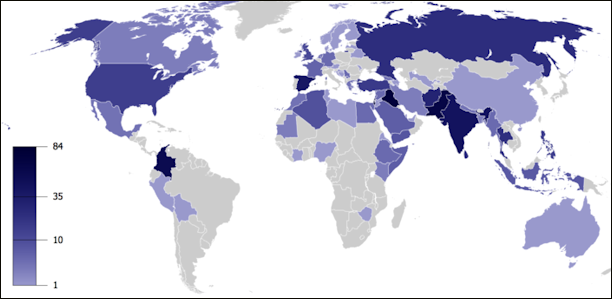
Number of Terrorist Incidents
Terrorists
The best terrorists are ones that don’t draw attention to themselves and avoid detection and know where to hide and carry out attacks when their enemy’s guard is down. Successful missions attract new recruits eager for action. But fame and exposure also bring more attention from authorities and make it easier for them to find terrorists. Many terrorists are relatives of other terrorists.
There are three kinds of Al-Qaida members and supporters: 1) the fighters formally based in Afghanistan or Pakistan that were directly under Al-Qaida’s control; 2) Islamic militants scattered around world that have various kinds of ties to Al-Qaida; and 3) non-militant supporters and admirers.
The second group is regarded as the most dangerous. Many were trained at Al-Qaida camps and operate in independent cells. They often hatch their own plans and rely on Al-Qaida mainly for financial and logistical support. They do not need to be in contact with Al-Qaida leaders and thus are difficult to detect and link to Al-Qaida.
The large number of well-educated but unemployed and frustrated young men — both in the Muslim world and outside it — are regarded as the ideal recruits. They are sometimes attracted by promises of 72 virgins in the afterlife if they die as martyrs in a suicide attack and by ideals of avenging injustices directed at Muslims and upholding the honor of Muslim women.
Elite Al-Qaida members travel around the globe using false identities and false passports. They shave off their beards and travel with duty-free alcohol to avoid detection. Many have lived in Europe or North America, speak good English or European languages and are comfortable and move freely in the West.
Islamic Terrorist Recruits
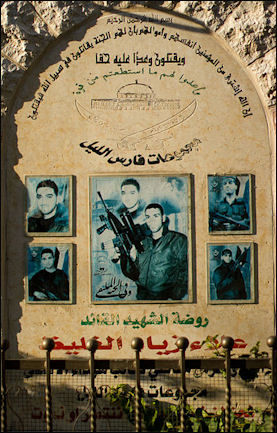
Nablus Martyrs memorial Like Hitler's Brownshirts and militant Serbs, Islamic terrorists are often of young males with no steady job and few hopes for the future. Many are believed to have dysfunctional or non-existent relationships with women and have been drawn in by Islamic ideology and propaganda and charismatic Islamic leaders. These young men lie at the heart of of the movement, some say, because they were willing to do anything they were told to do.
Some have little education but others are educated, even highly educated, and were star students when they were kids. Many unemployed young men are better educated than their parents, which only seems to increase their frustration and humiliation and make them more willing to do extreme things. Some come from villages and have moved to the cities which increases their alienation.
Some terrorists are true believers who believe with all their hearts in a religion, ideology, belief in ethnic superiority, desire to avenge perceived wrongs or a nationalist vision. They are willing to die for their cause. Others are opportunists and criminals who see a chance to make money, achieve power, commit crimes or pursue a personal agenda during a period of conflict and turmoil.
New Recruits to Islamic terrorism are often motivated by reports of injustices and violence inflicted on Muslim: the abuses of Abu Graib prison, pictures of Iraqi civilians with the head stepped on by American soldiers; videos of Israeli tanks destroying Palestinian houses. These are seen as acts of humiliation and are perceived as particularly reprehensible. As the conflicts and grievances grow, young men who otherwise would lead normal productive lives are drawn in or pushed in with calls of revenge and nationalism, especially if they are unemployed. Sometimes these men are reluctant participants but feel they have few normal job opportunities and feel they have no choice but to enter the fray. These individuals are often the first to escape from the conflict when the opportunity arises.
Young Arabs are aroused by their inability to get jobs and improve their lives. Their frustration grows as the world around them advances and they stagnate. They view the campaign against terrorism as an attack on Islam and seeth at the plight of the Palestinians and become convinced they doing something that is good and justified. One former militant told the Washington Post that persuading terrorists to end their targeting of civilians is difficult. “It’s about ideology. They believe what they’re doing is true. That it comes from God.”
Book: “Warrior of the Prophet: The Struggles for Islam” by Mark Huband, offers good insights into the radicalization of Islam.
Recruiting Terrorists and Brainwashing
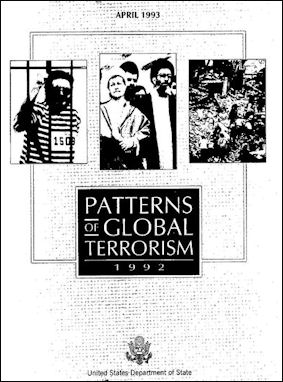
It is widely believed to that classic brainwashing techniques are used to radicalize young people and transform them into militants, terrorists and suicide bombers. Muslim extremist handlers seek out people who are young, impressionable and unhappy, traumatized, want to kill themselves anyway or have chips on their shoulders. Often bright, educated and ambitious young men that can’t find jobs are ideal candidates.
Next they are shown video of torturing and killing and told these are atrocities committed against Muslims by whatever enemy they chose. Some times subliminal messages are throw in to emphasize the point. A Russian authority on such techniques told the Los Angeles Times, “The video would show the torturing of prisoners of war or the killing of brother Muslims...And these images would be accompanied by the sound of the word “kill” at regular intervals and at critical, dramatic moments.”
Intensely studying the Koran can also have brainwashing aspects. The young recruits or students are often asked to repeat over and over phrases who meanings they don’t know, especially if Arabic is not their native tongue. The Russian expert said: “They’re gathered into large auditorium, and they repeat combinations of sounds whose meaning they have no idea of. At the same time they’re making very rhythmic motions...one of the simplest and most primitive entrancing technologies.” Then to top it off they are told a paradise awaits them if they kill themselves as martyrs.
New Muslim Converts, Madrassahs and Terrorism
.jpg)
Bosnia madrassah These days a increasing number of jihadists are new converts to Islam. Yacine Beyens, a Belgian convert who used to head a group called the Muslim Executive, told Time, “When converts are trying to find their way in their new religion, they’re vulnerable to the influences of extremists. They can sometimes be persuaded by radical preachers who claim to represent the “true” voice of Islam when in fact they represent nothing of he sort.”
Among those that participated in the London bombing in 2005 was Germain Lidsay, a Jamaican-born Briton. Gustav de Aristegui, a Spanish terrorism expert, told Time, “Originally jihadist groups were suspicious of converts because they saw them as a way for intelligence forces to infiltrate. But they’re realizing that...someone with a Western last name and blue eyes is going to raise fewer suspicions . Converts can be virtually impossible to detect, especially if they have not revealed their conversion to their family.”
Islamic students are a problem because they have no marketable skills and are unemployable. This increases their anger against society and make them more likely to become engaged in radical or terrorist activities. The Islamic schools are breeding grounds for extremists not only because of the ideology they teach but also because they don’t teach many skills that will help students get real jobs. When they are unemployed they are more likely to get involved in extreme activities.
Tips for New Al-Qaida Member
The Yemen-based Al-Qaeda in the Arabian Peninsula's (AQAP)’s Inspire magazine is a 67-page publication available from jihadist forums that are sometimes password-protected or otherwise difficult to access, according to SITE Intelligence, a US service that monitors Islamist websites. [Source: W.G. Dunlop, AFP, July 12, 2010]
"What to Expect in Jihad" offers advice for those who decide to take the fight abroad: "When coming to any land of jihad, it is important to be able to speak the local language fluently," the article advises. It also suggests that would-be mujahedeen (holy warriors) bring a friend with them, and that they learn as much as possible about local culture before travelling.
The article also offers packing advice, saying that, "When on jihad, one has to bear in mind that they will have to pack light." It goes on to recommend that mujahedeen bring a "well-built backpack," several pairs of weather-appropriate clothes, "body-cleansing items" and "flexible boots." Items such as computers and MP3 players can also be brought along. The article warns, however, that cell phones with SIM cards in place can be "dangerous," and, along with cameras, should not be used without permission. Religious books make up most of the section on reading material to bring.
Terrorists Anti-Detection Skills
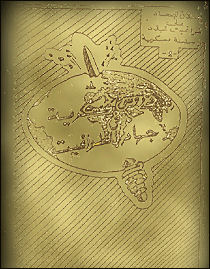
Cover of The
Manchester Manual Craig Whitlock wrote in the Washington Post: “In an age of spy satellites, security cameras and an Internet that stores every keystroke, terrorism suspects are using simple, low-tech tricks to cloak their communications, making life difficult for authorities who had hoped technology would give them the upper hand. Across Europe, al-Qaeda operatives and sympathizers are avoiding places that they assume are bugged or monitored, such as mosques and Islamic bookshops, counterterrorism experts said. In several cases, suspects have gone back to nature -- leaving the cities on camping trips or wilderness expeditions so they can discuss plots without fear of being overheard. [Source: Craig Whitlock, Washington Post, January 5, 2008]
“In Britain, a man who called himself "Osama bin London" is among five people being tried on charges of operating terrorist training camps in remote areas, sometimes under the guise of paintball fights in the woods. The camps' participants included four men who later tried to set off backpack bombs on the London transit system on July 21, 2005. In a separate case in London, a Ugandan immigrant is scheduled to go on trial this month on charges of receiving terrorist training in the New Forest, site of a former royal hunting ground established in the 11th century by William the Conqueror. And in Germany, three Islamic extremists suspected of plotting to bomb U.S. targets in September were arrested after police tracked them to the hilly resort village of Oberschledorn. Investigators said the suspects had rented a vacation home where they could stash ingredients for making explosives.
“Terrorism suspects are "certainly more careful," said Armando Spataro, the deputy chief public prosecutor in Milan. "They know we will intercept their conversations and track their mobile phone traffic." In November 2008, police in Milan announced they had broken up a long-standing network that had recruited suicide bombers to go to Iraq and Afghanistan. The investigation was based largely on a massive wiretapping effort by Italian police and resulted in the arrest of 20 suspects in Italy, England, France and Portugal. But the case took four years to build, in part because the targets assumed police were watching and eavesdropping on them.
“Wiretap transcripts and other court records show that the cell of North African immigrants tried hard to blend into Italian society, working regular jobs, sending their children to public schools and taking pains not to appear unusually religious. When they did talk on the phone, they often adopted a roundabout or obtuse manner that masked their real meaning. "You have to understand that there are some things everybody has to be careful about," Sabri Dridi, 37, an alleged captain in the Milan-based network, lectured one of his co-defendants in a call that he hinted, correctly, was being recorded by police. "Even going to visit a friend or relative can be suspect. You have to do things so that they don't notice you, because if they see somebody moving around all the time, they can really make things difficult."
Tips for the Traveling Terrorist
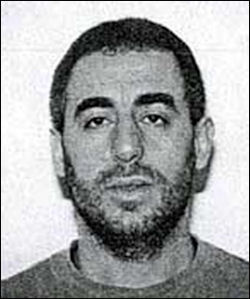
Mohammed Ali Hamadei
FBI Most Wanted Terrorist No. 6 Alan Cullison of the Wall Street Journal got his hands on a computer used by Al-Qaida. He wrote in the Atlantic Monthly, “The al-Qaeda desktop computer contains voluminous "security" files devoted to, among other things, modern spycraft. The training offered is practical; students are told, for example, how to photograph a bombing target, use invisible ink, and evade police surveillance. The computer's manuals also focus on the broader history of partisan warfare and refer to an eclectic collection of role models, among them Aristotle, Jesus, Ahmed Kamel (the former head of Egyptian General Intelligence), and even the Israeli leader Menachem Begin, whose book The Revolt (1951), about his days as a terrorist fighting British rule in Palestine, is quoted approvingly at great length. The manuals devote special care to teaching recruits how to pass unnoticed in the West, and include the following advice: Don't wear short pants that show socks when you're standing up. The pants should cover the socks, because intelligence authorities know that fundamentalists don't wear long pants [Source: Alan Cullison, The Atlantic Monthly, September 2004, from files found on a computer used by Al-Qaida leader Ayman al-Zawahiri]
If a person, for example, wears a T-shirt or a shirt that has the drawing of a spirit — that is, a bird, an animal, etc.”don't cut off the head [the Islamic tradition frowns on the depiction of living beings]. Either wear it with the drawing, or don't wear it at all. Moreover, you should never carry any item of clothing in your suitcase where the pictures have been tampered with, or where the head of the animal or bird has been cut off. Don't wear clothes made in suspect countries such as Iran, Pakistan, Iraq, Libya, Sudan, North Korea, Cuba, etc.
Underwear should be the normal type that people wear, not anything that shows you're a fundamentalist. A long time before traveling — especially from Khartoum — the person should always wear socks and shoes, to get rid of cracks [in the feet that come from extended barefoot walking], which take about a week to cure — If the mission requires wearing a chain, you should show it by opening the top buttons of the shirt.”
Never use the perfumes used by the brothers [fundamentalists]. You should differentiate between: a) Perfume used only after shaving?"After Shave" is written on the bottle. This type is used only on the chin and nowhere else. b) Perfumes — marked "Lotion" — that are placed anywhere on the clothes, on the head, behind the ears, etc. You should use the type of perfume for the underarms that usually comes in the shape of a soap ball. You should never use any other type of normal perfume under the arms. You should differentiate between men and women's perfume. If you use women's perfume, you are in trouble.
Terrorist Codes

Ibrahim Salih
Mohammed Al-Yacoub
FBI Most Wanted Terrorist No. 1 Often, suspects use simple, homemade codes in their exchanges. In a trial in the German city of Kiel, a Moroccan-German man charged in a separate case with recruiting suicide bombers to go to Iraq revealed in testimony in November some of the rudimentary ciphers that he and other cell members used in Internet chat forums. "Taxi drivers," Redouane el Habab said, referred to suicide bombers; explosives were "dough." Anybody who had to go to "the hospital," he added, had been taken to jail, while those visiting "China" were really attending training camps in Sudan. [Source: Craig Whitlock, Washington Post, January 5, 2008]
“Experts said the codes may not appear sophisticated at first glance but can be time-consuming to crack, especially if the targets are conversing in Arabic. In September 2005, a British court convicted Andrew Rowe, a Jamaican convert to Islam, on terrorism charges after authorities found a secret code book in which he gave double meanings to the brand numbers of Nokia phones.
“Pretending to be a traveling cellphone salesman, Rowe would use "Nokia 3310" to refer to money, "Nokia 3410" to signal potential trouble from the police and "Nokia 3610" as code for weapons. Rowe received a 15-year prison sentence, even though prosecutors and police said his precise plans remained a mystery. "They are very creative on this front. It is one of the most interesting dimensions in this cloak-and-dagger war on terrorism," said Magnus Ranstorp, a terrorism analyst at the Swedish National Defense College . "They are incredibly aware when they use any electronic means to communicate that they can be monitored by the intelligence services all over the world, not just Europe."
“Coded language was also cracked in the FBI investigation of Jose Padilla, the Brooklyn-born al-Qaeda follower who was convicted last August of conspiracy to commit murder. According to prosecutors, Padilla and two co-defendants were bugged for years by the FBI, which eventually concluded that their frequent mentions of "eggplant" and "zucchini" were really references to weaponry and ammunition.
New Generation at Al-Qaida
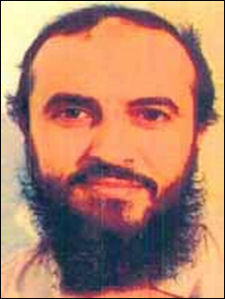
Jamel Ahmed Mohammed
Ali Al-Badawi
once FBI Most Wanted Terrorist Marc Sageman wrote in the Washington Post: “Such key 9/11 plotters as Mohamed Atta, Ramzi Binalshibh, Ziad Jarrah and Marwan al-Shehhi met and became radicalized as students in Hamburg, then went to Afghanistan looking for al-Qaeda. But over the past six years, most of the professional terrorists who fit this profile have been eliminated during the U.S.-led manhunt for "high-value targets." The few that remain are huddled in the Afghan-Pakistani border area, struggling to extend their reach beyond Pakistan. [Source: Marc Sageman, Washington Post , June 8, 2008; Sageman is a sociologist, forensic psychiatrist and scholar in residence at the New York Police Department. He is the author of "Understanding Terror Networks" and "Leaderless Jihad."]
“That old guard is still dangerous and still plotting spectacular attacks. But it is the new wave that more urgently requires our attention. This cohort is composed of homegrown young wannabes who dream of glory and adventure, who yearn to belong to a heroic vanguard and to root their lives in a greater sense of meaning. Inspired by tales of past heroism, they hope to emulate their predecessors, even though, for the most part, they can no longer link up with al-Qaeda Central in the Pakistani badlands. Their potential numbers are so great that they must now be seen as the main terrorist threat to the West.
“Unlike their pre-9/11 predecessors, today's would-be terrorists are usually the poorly educated teenage children of unskilled and secular Muslim immigrants. They have been born, raised and radicalized in their host countries (unlike, say, Atta, an Egyptian who recoiled at modern Germany). This new generation's youth culture celebrates a sort of "jihadist cool." Consider the "Hofstad Netwerk" in the Netherlands, which I believe is typical of this new wave. It consists mostly of young people who were born in Holland or immigrated to that country very early in life. They met around their neighborhoods, in Internet cafes or in online chat rooms, then self-radicalized through their admiration for the supposed Islamist heroes fighting the West. One man linked to this cohort, Mohammed Bouyeri, repeatedly shot the Dutch filmmaker Theo van Gogh in 2004 on an Amsterdam street. Other members of this informal network reportedly planned to murder prominent Dutch politicians and bomb the Dutch parliament, a nuclear power plant and Amsterdam's international airport.
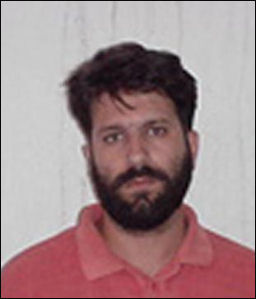
Jamal Saeed Abdul Rahim
another FBI Most Wanted Terrorist “Unlike their fanatical predecessors in the old al-Qaeda, the new terrorists are not particularly religious. The defendants in the Hofstad trials, the March 2004 Madrid bombing trial, the Toronto case and the many trials in Britain are not intellectuals, let alone Islamic scholars. Many became religious only a few months before their arrests, and some are not religious at all. The new generation is not likely to be swayed by abstract arguments. Young jihadist wannabes do not go to Iraq to have theological debates; they go there to blow themselves up.”
“The problem has been worse in Europe than in the United States. In the land of the American dream and the melting pot, a broader, more inclusive view of American-ness undermines the jihadist insistence that the U.S. government is at war with its Muslim citizens. Notwithstanding some ugly jeering by nativist bigots and some clumsy profiling by law enforcement, ordinary Muslim Americans simply do not feel some "war on Islam" in their daily experiences. But things are far less cheerful in Europe. The children of unskilled Muslim immigrants there face discrimination across the continent, resulting in striking unemployment rates. Many non-Muslim Europeans resent having to compete with Muslim immigrants for low-level jobs and worry that poor immigrant suburbs mean higher crime rates. Anti-immigrant sentiment, which propelled far-right parties to win around 20 percent of the vote in contests in France, Austria and Switzerland in recent years, only reinforces the message of rejection -- and produces grist for the terrorists' mill.
“There are many angry young Muslims in the world, of course. What transforms a tiny number of them into terrorists is mobilization by networks. Until a few years ago, these networks were made up of face-to-face groups: local gangs of young immigrants such as the Hofstad group or expatriate students such as the Hamburg cell that planned 9/11. These cliques of friends became radicalized together. The group acted as an echo chamber -- amplifying grievances, intensifying members' bonds to one another, deepening their rejection of the values of the host society and making it easier to gradually separate themselves from it.
“Over the past two or three years, face-to-face radicalization has started to be replaced by online radicalization. People's beliefs used to be changed in small cliques; now they are being altered in jihadist Internet forums. These forums have become virtual marketplaces for extremist ideas -- the "invisible hand" organizing terrorist activities worldwide. They are transforming the terrorist movement, attracting ever younger members and women, who can now join in the discussions.
The new generation outside Europe has also been shaped by the wars in Iraq and Afghanistan. John Arquilla of the Naval Postgraduate School told Newsweek the Iraq War helped create a more skilled new generations of jihadists: "They're getting re-educated," he says. "The first generation of Al Qaeda came through the [Afghan] camps. The second generation are those who've logged on [to Islamist Web sites]. The next generation will be those who have come through the crucible of Iraq. Eventually, their level of skill is going to be greater than the skill of the original generation."
Image Sources: Wikimedia Commons, FBI
Text Sources: New York Times, Washington Post, Los Angeles Times, Times of London, The Guardian, National Geographic, The New Yorker, Time, Newsweek, Reuters, AP, AFP, Wall Street Journal, The Atlantic Monthly, The Economist, Global Viewpoint (Christian Science Monitor), Foreign Policy, Wikipedia, BBC, CNN, NBC News, Fox News and various books and other publications.
Last updated July 2012
